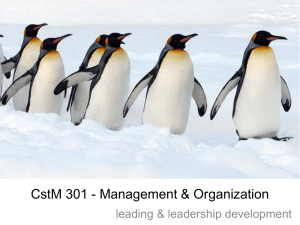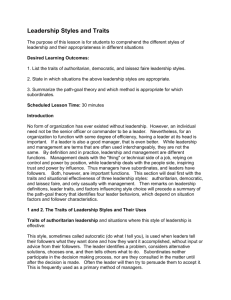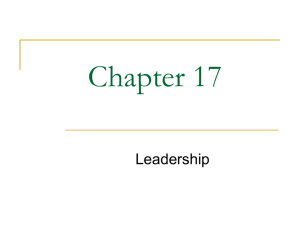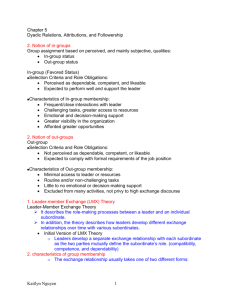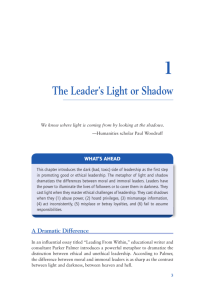Unit 4 - Final Exam Time Remaining: 1. The central explanatory
advertisement
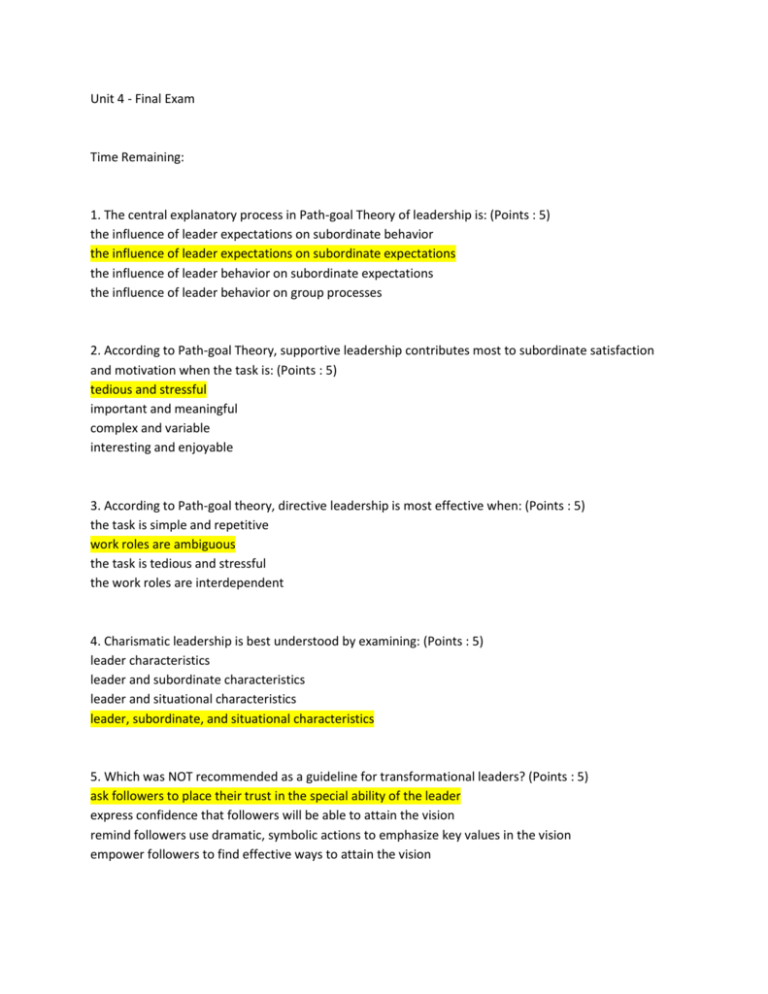
Unit 4 - Final Exam Time Remaining: 1. The central explanatory process in Path-goal Theory of leadership is: (Points : 5) the influence of leader expectations on subordinate behavior the influence of leader expectations on subordinate expectations the influence of leader behavior on subordinate expectations the influence of leader behavior on group processes 2. According to Path-goal Theory, supportive leadership contributes most to subordinate satisfaction and motivation when the task is: (Points : 5) tedious and stressful important and meaningful complex and variable interesting and enjoyable 3. According to Path-goal theory, directive leadership is most effective when: (Points : 5) the task is simple and repetitive work roles are ambiguous the task is tedious and stressful the work roles are interdependent 4. Charismatic leadership is best understood by examining: (Points : 5) leader characteristics leader and subordinate characteristics leader and situational characteristics leader, subordinate, and situational characteristics 5. Which was NOT recommended as a guideline for transformational leaders? (Points : 5) ask followers to place their trust in the special ability of the leader express confidence that followers will be able to attain the vision remind followers use dramatic, symbolic actions to emphasize key values in the vision empower followers to find effective ways to attain the vision 6. Which was recommended for leaders when communicating the vision? (Points : 5) set a concrete deadline for attaining key aspects of the vision explain in a general way how the vision can be attained remind followers about the obstacles so they do not become complacent offer incentives to followers for their help in attaining the vision 7. Which of the following is LEAST likely to be a reason for resistance by employees to a proposal by top management to change the current strategy? (Points : 5) a climate of distrust in the organization the fear of losing status and power cynicism about the feasibility of the proposed change resentment of external dependencies 8. What type of culture is most likely to facilitate long-term performance by an organization in a turbulent environment? (Points : 5) a culture that strongly supports the current competitive strategy a culture consistent with the values of the most powerful subunit a culture that emphasizes the need for flexibility and continuous learning a culture that creates goal alignmnet among organization members 9. A successful vision for an organization is most likely to include: (Points : 5) specific performance objectives with a clear deadline a memorable slogan about the key value to be achieved a list of desirable features for the organization's products or services a vivid image of what can be achieved and why it is worthwhile 10. Which of the following is LEAST desirable for a vision? (Points : 5) it should emphasize ideological objectives it should be clear and easy for followers to understand it should be bold and ambitious it should include detailed action steps to make it credible 11. What is the best way to describe the essential processes in learning organizations? (Points : 5) acquisition of new knowledge by the organization diffusion of new knowledge to people who can use it application of new knowledge by the organization acquisition, diffusion, and application of new knowledge in the organization 12. Which of the following is most useful approach for developing a learning organization? (Points : 5) encourage employees to become specialists in functional areas encourage systems thinking by managers at all levels of the organization create a reward system that fosters competition among employees use limitation of competitors as the primary basis for innovation 13. Which was not an important type of social influence process in groups? (Points : 5) social identification emotional contagion social enhancement social pressure 14. Which of the following was not mentioned as a primary determinant of performance for a functional team? (Points : 5) how long the current leader has been in that position trust and cooperation among the team members the organization and coordination of activities member agreement about objectives and strategies 15. Which of the followinwg was not mentioned as a reason for high team performance? (Points : 5) high collective efficacy for team members diverse mental models for team memberrs collective identification of members with the team high level of member skills relevant to the task 16. The greatest amount of shared leadership is likely to be found in: (Points : 5) a self-managed operational team a quality circle a cross-functional project team a virtual team 17. Which condition is least likely to limit a chief executive's discretion to make major changes in the strategy of an organization? (Points : 5) the organization has a few major clients who account for most sales the organization has ample financial reserves the culture of the organization is strong the organization has a strong board of directors 18. Which is not a major obstacle in evaluating ethical leadership for individual leaders? (Points : 5) lack of interest in ethical leadership among scholars difficulty in determining if the ends justifies the means cultural differences in standards of ethical behavior the subjectivity inherent in the selection of criteria 19. Which of the following was not a recommendation for ethical leadership behavior? (Points : 5) stay neutral in political conflicts involving ethical issues set an example of ethical behavior in your own actions initiate discussions among followers about ethics and integrity recognize and reward ethical behaviors 20. Which condition is most likely to encourage ethical behavior in organizations? (Points : 5) strong emphasis on individual productivity cultural values for obedience to authority intense competition for valued rewards cultural values for individual responsibility
